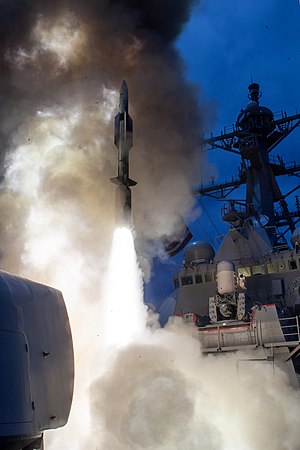
Back الصاروخ القياسي SM-6 Arabic SM-6 Bulgarian RIM-174 Standard ERAM Czech RIM-174 Standard ERAM Spanish RIM-174 Standard ERAM Finnish RIM-174 Standard ERAM French SM-6 HE RIM-174 Standard ERAM ID RIM-174スタンダードERAM Japanese RIM-174 스탠더드 ERAM Korean
| RIM-174 ERAM Standard SM-6 | |
|---|---|
 USS John Paul Jones launches a RIM-174 in June 2014 | |
| Type |
|
| Place of origin | United States |
| Service history | |
| In service | 2013–present |
| Used by | United States Navy Royal Australian Navy[1] Japan Maritime Self Defense Force[2] Republic of Korea Navy[3] |
| Production history | |
| Manufacturer | Raytheon |
| Unit cost |
|
| Produced | 2009–present |
| No. built | 500[5] (1,800 planned)[6] |
| Specifications | |
| Mass | 3,300 lb (1,500 kg) |
| Length | 21.5 ft (6.6 m) |
| Diameter | 13.5 in (0.34 m) for Block IA 21 in (0.53 m) for Block IB |
| Wingspan | 61.8 in (1.57 m) |
| Warhead | 140 lb (64 kg) blast fragmentation[7] |
Detonation mechanism | Radar and contact fuze |
| Engine | Two stage: solid rocket booster, solid rocket booster/sustainer |
Operational range | 130 nmi (150 mi; 240 km)[8] or upwards of 250 nmi (290 mi; 460 km)[9] around 500 km against land targets[10] |
| Flight ceiling | >110,000 ft (34,000 m) |
| Maximum speed | Mach 3.5 (2,664.2 mph; 4,287.7 km/h; 1.2 km/s) |
Guidance system | Inertial guidance, terminal active and Semi-active radar homing |
Launch platform | Mk 41 VLS (surface ship), Strategic Midrange Fires (ground launcher), Boeing F/A-18E/F Super Hornet (air-launched),[11] |
The RIM-174 Standard Extended Range Active Missile (ERAM), or Standard Missile 6 (SM-6), is a missile in current production for the United States Navy (USN). It was designed for extended-range anti-air warfare (ER-AAW) purposes, providing capability against fixed and rotary-wing aircraft, unmanned aerial vehicles, anti-ship cruise missiles in flight, both over sea and land, and terminal ballistic missile defense. It can also be used as a high-speed anti-ship missile.[12] The missile uses the airframe of the earlier SM-2ER Block IV (RIM-156A) missile,[13] adding the active radar homing seeker from the AIM-120C AMRAAM in place of the semi‑active seeker of the previous design. This will improve the capability of the Standard missile against highly agile targets and targets beyond the effective range of the launching vessels' target illumination radars. Initial operating capability was planned for 2013 and was achieved on 27 November 2013.[14] The SM-6 is not meant to replace the SM-2 series of missiles but will serve alongside and provide extended range and increased firepower.[15] It was approved for export in January 2017.[16] An air-to-air variant of the SM-6, known as the AIM-174, is the first dedicated long-range air-to-air missile employed by the USN since the 2004 retirement of the AIM-54 Phoenix.[17] SM-6 can also be fired from the U.S. Army's Typhon missile launcher as part of the Strategic Mid-range Fires System (SMRF).[18]
- ^ "Australian Defence White Paper 2009" (PDF). defence.gov.au. Archived (PDF) from the original on 26 December 2023.
- ^ "Japan Eyes More Muscular Defense". Japan Space Policy. Archived from the original on 11 November 2014. Retrieved 29 September 2014.
- ^ "South Korea to purchase Standard Missile-6 interceptors". Navy Recognition. 26 April 202. Archived from the original on 25 November 2023.
- ^ "Comprehensive Selected Acquisition Reports (SARs) For the December 31, 2017 Reporting Requirement as Updated by the President's FY 2019 Budget" (PDF). U.S. Dept of Defense. 31 December 2017. Archived (PDF) from the original on 1 February 2022.
- ^ "Standard Missile-6 (SM-6)". Missile Defense Advocacy. March 2023. Archived from the original on 28 December 2023.
- ^ LaGrone, Sam (4 August 2015). "Successful SM-6 Ballistic Missile Defense Test Set To Expand Capability of U.S. Guided Missile Fleet". U.S. Naval Institute. Archived from the original on 18 September 2023.
- ^ Ho, Ben (10 March 2016). "Fixing the US Navy's Anti-Surface Warfare Shortfall". The Diplomat. Archived from the original on 25 November 2023.
- ^ Tegler, Eric (10 February 2016). "The Navy's Air Defense Missile Will Become a Supersonic Ship Killer". Popular Mechanics. Archived from the original on 26 November 2023.
- ^ https://www.navalnews.com/naval-news/2022/04/south-korea-to-acquire-sm-6-missiles-for-kdx-iii-batch-ii-destroyers/ [bare URL]
- ^ "The return of long-range US missiles to Europe". IISS.
- ^ "The Weekly Debrief: Air-launched, SM-6-like Missile Exposed In New Test Photo | Aviation Week Network". aviationweek.com. Retrieved 4 April 2024.
- ^ Majumdar, Dave (8 March 2016). "How to Sink Warships: U.S. Navy Reveals Anti-Ship SM-6 Missile". The National Interest. Archived from the original on 9 March 2016.
- ^ "Standard Missile-6". Raytheon. Archived from the original on 28 October 2012. Retrieved 10 February 2011.
- ^ "Standard Missile 6 (SM-6) Achieves Initial Operational Capability". Naval Sea Systems Command. 27 November 2013. Archived from the original on 3 November 2014. Retrieved 29 October 2014.
- ^ Freedberg Jr, Sydney J. (19 August 2014). "Non-Standard: Navy SM-6 Kills Cruise Missiles Deep Inland". Breaking Defense. Archived from the original on 25 March 2023.
- ^ LaGrone, Sam (10 January 2017). "SM-6 Cleared for International Sale; Australia, Japan, Korea Could Be Early Customers". U.S. Naval Institute. Archived from the original on 11 January 2017.
- ^ Cenciotti, David (3 July 2024). "First Images Emerge Of U.S. Navy Super Hornet Carrying Two Air-Launched SM-6 Missiles". The Aviationist. Retrieved 7 July 2024.
In essence, this new missile fills the gap left by the retirement of the AIM-54 Phoenix. The AIM-54 was a long-range air-to-air missile used by the U.S. Navy's F-14 Tomcat and retired in 2004 alongside the F-14. Known for its impressive range of over 100 nautical miles and multiple-target engagement capability, the AIM-54 left a significant void in long-range engagement capabilities.
- ^ Schulenburg, Rupert (5 April 2024). "US ground-based conventionally armed missile programmes stretch their wings". International Institute for Strategic Studies.